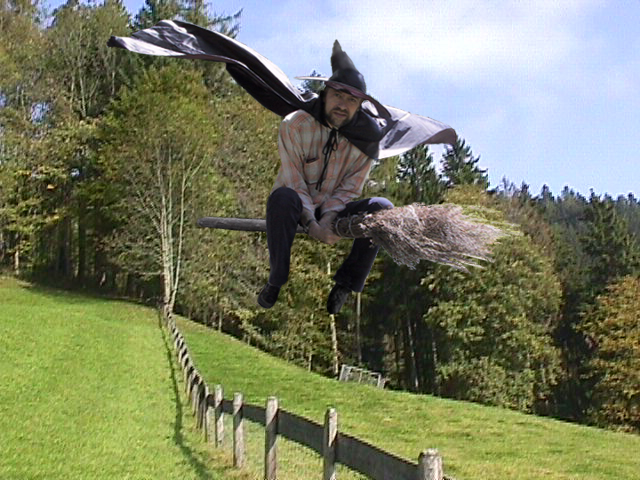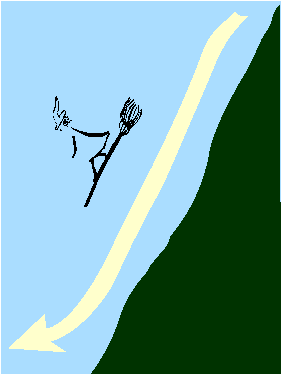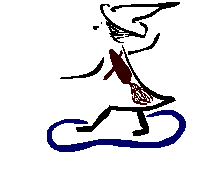|
There are lots of broomriding games and sports all over the world, most of them are specific to their landscape and to the broomriders living there. Some of them, however, are international and have regular competitions. Learn here more about the most common ones, which are: |
||
Broom RacingBroom Racing originated in iBa's testing community. As a matter of fact, the association had to be sure that the broom's spellset was strong enough at any speed before the CST-mark could be given to the new model. Therefore, professional independent test flyers were hired. Well - at any speed! We know today that it's far more difficult to hold your direction, and keep your elevation at low speed, because the forces of the wind affect the rider much more strongly. But racers still insist they can deal with instantly changing aerial circumstances and suddenly appearing obstacles. Famous broom races... up to the top | subscribe to a club |
 |
|
Broom Chasing GamesBroom chasing games are the best practice to coordinate your air movements and to have fun at the same time, and there are numerous variations. The broom game specialist Pico Lotto Mapleleaf collected in his 1999 book 58 different broom chasing games, from chasing other riders to chasing objects or flying animals. At the moment being, we don't offer any specific classes to the subject, but broom chasing games are part of the broom flying, as well as the formation gliding eucation. up to the top | subscribe to a club |
||
Skill CoursesLike the concept of broom racing, the idea of broom skill courses has its origins in broom testing. In the late 1970s, AIDBV broom testers boasted that their broom models had fewer accidents than iBa tested ones. Actually, this was the case due to a series of nasty accidents in and around Denmark and South Sweden, called "the Scandinalian Misty Chain". The Scandinavian iBa deputy was convinced that this "misty chain" had nothing to do with the then new popular broom model "Flap-n-Up" and suggested testing not only the maintenance of speed, height and direction, but also the astuteness of the new broom models. In his need for action, the deputy summoned Scandinavian's 12 best broomriders with their most recent models and invited the same number from France, the BeNeLux and Canada to compete with each other on a course set up for this purpose on the Lofote Islands off the northern Norwegian coast. This first skill course consisted of racing from the tip of a mountain down to the small fishing village Nusfjord, taking a quick stop neatly above the surface of the water, taking a rock out out of it and enchanting it to be a dried stockfish able to sing the song of the wind during the rest of the broom tester's flight, pinching a pair of stockfish off the line, reviving it and letting it splash back into the water, then racing up the mountain again. The iBa team won by a wide margin, whereupon AIDBV's teamleader claimed that the course was unfair, particularly the French team mates weren't used to performances in "such criminal altitudes, icy cold weather and never-ending twilights". Today, skill courses are open to the public, not only to the testers. Several international ones take place a year, usually in special areas like bewitched forests or grottos, deserted tunnels or mines. The most popular international Broom Skill Courses takes place on September weekends in Portugal's costal region Algarve (Ponta de Dona Ana) and in the Caldeira grotto on Garaciosa, in the short periode between the summer and autumn tourist seasons. The miles above the sea from Ponta de Dona Ana to Garaciosa are crossed by a broom race. Some participants only attempt the course because of this middle sequence. up to the top | subscribe to a club |
||
Wind Wave Riding"Broomriding has almost always to do with wind wave riding" you may argue. This is true. As long as you stay with the ordinary more or less gentle winds of your own surroundings, you may enjoy a soft shake now and then. But there are other winds, and they are what this sport is all about. Wind wave riders of the Danube countries fight with strong winds blowing constantly in the same regions. Their challenge is for example to keep their position during weeks above Vienna. Wind wave riders in Pakistan and India prove their skills in the monsoon winds, and the best of them is the one who keeps dry untill the end. Members of the broom rider's association of Alpine countries (France, Switzerland, Italy, Germany, Austria and Slovenia) have discovered their own very special aerial delights: wind wave riding in the Föhn, Boreas or Mistral. The Alpine north and south winds are known to be incredibly fast, dangerous, malicious and hot. Natives call them "grapecookers" and "snowlickers" - as they are able to melt meters of snow in hours. Sailors and fishermen fear the sudden dangers of these romping and berseking winds, and Alpinists respectfully consult the sky and the air pressure cards before departing on tour. The broomriders, however, know about the powerful counterforce of their special spells and go for a quick and violent ride. They enjoy being shaken thoroughly and being pushed into the churned up lakes like the Lake of Lucerne or the Lago Maggiore in Switzerland, as well as the Bohinjsko Jezero in the Slovenien Triglav National Park. US-American wind wave riders have discovered the Rockies and their unbridled hot wind chinook. Their inconvenience is, that the chinook is often stronger than the falling winds of alpinian countries, and that there are less lakes to drop in when they lose control of their brooms. Caution: wind wave riding is not for beginners and we don't recommend it to anybody with less than five years of serious broomflying study! Take wind wave riding lessons, listen to your teacher, learn special protecting spells, buy the necessary equipment, study the weather carefully and be aware of the dangers. These are the six basic rules of wind wave riding, and the seventh and most important is: never go alone. This is really not a sport for careless people, unless they are eager to lose their heads. up to the top | subscribe to a club |
 |
|
BroomballBroomball is similar to handball, but you play it on your brooms in the air with a constantly growing and shrinking ball. There are nine players and a goalkeeper in each team. The slightly etched, fire red ball must enter a basket formed by a thick cloud. Causing rain will take points from the respective team. |
||
Aerial Ping-PongAerial Ping-Pong is played with clubs on brooms on the surface of a relatively calm water. The golf-sized ball is bewitched to be water repellant. The most popular ball is being reflected by an air humidity of 90% and is therefore not suited to playing in rain, mist or clouds. Lakes of boiling water are a preferred location for the game. As the 90% humidity surface is very difficult to see, even for well-trained sportsmen, the direction and speed of the ball's reflection is hard to guess and the players have to be able to accelerate, stop and change direction in split seconds. An Aerial Ping-Pong team consists of two players and sometimes a reserve. The Grand Final is held every February 29 above the boiling lakes in Rotorua district, New Zealand. up to the top | subscribe to a club |
||
Cloud Surface GlidingCloud Surface Gliding was originally developed by a group of wave surfers. While testing their surf boards in a bewitched training hall above the clouds, they discovered that surfing on water and surfing on clouds have much in comon, such as the constantly moving surface underneath. However, they also have completely different pre-conditions, such as the strong winds around a cloud, the soft transition from cloud to air, the immediate end of a cloud (the highly dangerous cloud hole) and the rumbling, bumping and banging air turbulences inside and around the cloud which are much stronger than even at sea coasts. Besides, very different equipment is required: the board is wider and shorter, and the cloud surface riders recommendedly carry a collapsible broom as well as a parachute in their back pocket. up to the top | subscribe to a club |
 |
|
Waterfall SlippingSupposed to be the Canadian National Sport, but also common in many other countries, waterfall slipping is based on the attempt to slide down the falling water without diving into the pond below. That's what you need your broom for. The broom may be bewitched to stop the fall and take own speed in the second before the crash. it can also be bewitched never to touch water, which causes the same effect of taking off inches above the ground. Waterfall slipping can go terribly wrong for broomriding amateurs, especially if they don't master perfectly taking off at the right split second. up to the top | subscribe to a club |
||
Broom BungieBroom Bungie, not unlike bungie jumping, means jumping off your bungie broom. The broom registres its height at the moment you left it as well as your weight. It calculates the time you will fall and activates automatically a summoning spell a second before you will touch the ground. That's how you are transported back to your broom. Broom Bungie was originally invented not for the sportsmen, but for broomriding schools - as a training for broom accidents. It is indeed a goog opportunity to learn how to fall and to cast the right spells when another pupil slipps off his or her broom. the discipline is recent - a class will only be formed if there are enough students up to the top | subscribe to a club |
||
Broom SailingBroom Acrobats from Finland, while standing on their brooms with wide garments, discovered broom sailing in the circular winds above lakes and in the upwinds above forrests. Broom sailing is dealing with and conquering the winds, it's a technical challenge. Broom Sailors fly either alone or in pairs on specially equipped brooms, which are designed for this puropse. up to the top | subscribe to a club |
 |
|
Broom FightingBroom Fighting is quite a new broomriding sport. Usually, you fight in mid air with a weapon which can be
Keeping on your broom and throwing your opponent from his or her, is the aim of the game. Fighting with wands includes casting spells, while fighting with animals requires a well-trained pet accustomed to the rules of the game and trained to jumping from broom to broom. up to the top | subscribe to a club |